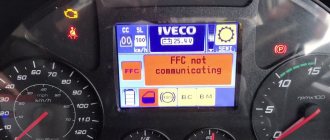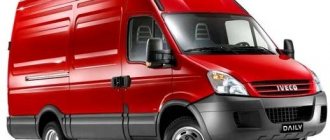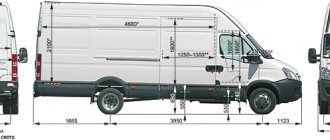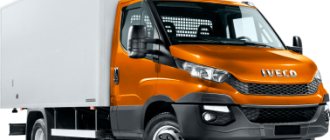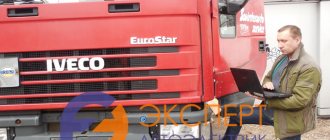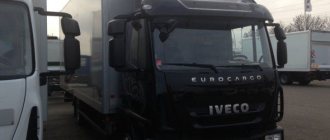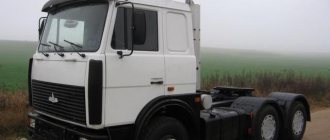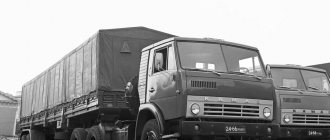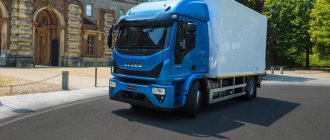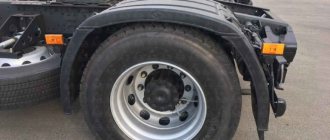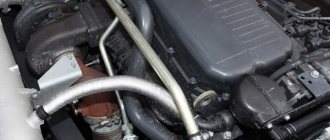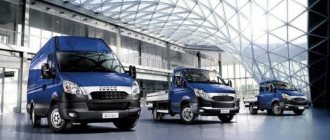IVECO of the new century
Pavel Gamankov, photo by the author
| Manufacturer: | IVECO |
| Model: | Stralis AT440S 43TP RR |
| Start of sales in Russia: | 2008 |
| Price: | 68,325 euros |
Serial production of Iveco Stralis trucks started in 2002. And a year later, this “saddle truck” was recognized as “Best Truck of the Year.” Less than five years have passed since the car was modified and updated. Considering that there have been no serious complaints about Stralis cars before, such a rush looks strange. What will surprise us with the updated “saddle bar” from Iveco?
Despite the 2007 restyling, which mainly affected the truck's cab, the updated Stralis is difficult to distinguish from its predecessor. The main external difference was such a small thing as the names of the make and model of the car spaced vertically. It turned out that this is the manufacturer’s response to the wishes of customers who want to place a logo with the name of their own company on the front grille of trucks. And there was simply no room for a sticker on the “face” of the old Stralis. Now this, so to speak, “problem” has been solved. It might seem like a small thing, but in the fight for a client, any means are good.
Other differences are less noticeable - the shape of the radiator grille has changed slightly, the shape of the side outer walls of the cabin has been adjusted, which has reduced the aerodynamic drag coefficient by 2%. In fact, the “facelift” ends here. Although no. The top versions of the new Stralis are equipped with Active Space cabins “expanded” to 2480 mm, which lack the characteristic feature of the “old” Stralis in the form of wheel arches that protrude widely beyond the dimensions of the cabin. But this “does not threaten” the domestic carrier. The overwhelming majority (about 85%) are supplied to Russia with simpler Active Time (as on the test tractor) and Active Day (low “daytime”) cabins, which have a cabin width similar to their ancestors (2280 mm) and the same protruding wheel arches .
The arrangement of the front optics in one block, characteristic of Stralis, remains unchanged. This is done so that a single protective grille can cover the headlights, foglights and turn signal indicators. Practical. But the bumper itself is still solid, and in case of minor damage it will not be possible to replace it in parts.
Generations
The Iveco SPA concern assembles trucks at factories located in China, Australia, Brazil and Argentina. Each generation of truck tractor has good factors, including:
- Comfort;
- High resource of power plants;
- Reliable transmissions;
- Low fuel consumption.
Thanks to the meticulous work of engineers and constant improvements, it is a serious competitor to such market monsters as Mercedes-Benz, Man and Volvo.
1st generation Iveco Stralis
In mid-2002, the concern launched mass production of a new type of long-haul tractor. The modification replaced the already well-known EuroStar and EuroTech models.
The new product was an incredible success. It combined the best qualities of tractors from well-known manufacturers. A unique feature was the design of the car and the presence of an automatic transmission. And this is already in the basic configuration. This proposal allowed the company to top the list of market leaders along with Mercedes and Man. The rich configuration of the Iveco Stralis, impressive resource and reasonable price made the car one of the most popular tractors of that time.
A recognizable feature of the car’s appearance was the radiator grille, which took the shape of the letter – U. It was also effectively complemented by a bumper, unusual for experts and carriers, in which head optics were built-in. The first buyers emphasized the large size of the rear-view mirrors, which provide a much better view than in other models. All these advantages allowed the truck to earn the honorary title of Truck of the Year in 2003.
This was followed by the release of two additional modifications. The Iveco Stralis Active Day tractor was designed exclusively for daytime transportation. There was no sleeping space in the cabin, and its dimensions were shortened. And the Active Time configuration was already equipped with an extended cab. It had a choice of 1 or 2 beds.
Restyling of the 1st generation
2007 was marked by changes in the ergonomics and appearance of the machine. The main changes affected the design of the bumper, which included completely new headlights. The main update was the appearance of a new Active Space Cube model in the lineup. It received the most spacious and dimensional cabin.
2nd generation
The next significant change occurred in 2012. The modification began to look more modern. Engineers have retained the famous radiator grille shape, although it has been significantly redesigned. To facilitate the design of the car, the bumper is made of high-quality and lightweight plastic. It, like the previous model, contains headlights, which are now presented in separate blocks.
3rd generation
At the beginning of 2016, the next generation of the popular Iveco model debuted. Three modifications became available to the company’s clients:
- NP is a truck tractor that consumes liquefied gas instead of diesel fuel. Gas has made freight transport much more environmentally friendly;
- XP is an international long-haul tractor. It is designed for long-distance flights and has an increased engine life;
- The standard equipment of the Iveco Stralis 2022 is a regional truck. It can also be used to deliver any type of cargo over short distances.
The new generation was designed based on the Hi-Way configuration. This decision was made by the brand’s management because the original modification had already proven itself to be a reliable special-purpose vehicle. The new product complies with the Euro-6 environmental standard.
Engineers created new electronics, rear suspension design, gearbox and completely redesigned the line of power plants. The braking system has also undergone significant changes.
All of these improvements have made it possible to significantly reduce the level of fuel consumption of Iveco Stralis. The savings amounted to about 11%. It was also possible to install a special Smart EGR system. It optimized fuel combustion.
Iveco stralis tractor: technical characteristics, reviews
Stralis is a family of heavy-duty trucks from the Italian brand IVECO, which now belongs to the transnational concern CNH Industrial, part of the FIAT Group. The range of modifications includes two- and three-axle vehicles: both truck tractors, which will be discussed today, and chassis for various bodies and superstructures, which are much less common in Russia. One of the advantages of IVECO equipment compared to its competitors is its interesting price. However, the difference of half a million to a million rubles - if you compare Stralis with analogues, say, from Mercedes-Benz or Volvo - does not seem to be enough to seriously displace the traditionally leading brands in the Russian market. Hence the rather modest eight thousand cars for the entire country (see table of data from the analytical agency Autostat). This is partly due to much lower demand on the secondary market - in those years when used “Germans” came to us in droves, the first generation Stralis was still young, and therefore expensive. And in general, it was not customary to go for cars to Italy and Spain, where there is a good choice of the IVECO brand - why, if two days' journey to the west there is Germany, which is replete with a variety of cars? Nevertheless, the successful work of the Iveco SpA representative office, the widespread distribution of Trakker dump trucks (they have been assembled in Russia since 1994) and, as a result, the expansion of the dealer network have done their job. Quite large transport enterprises began to purchase Stralis tractors in batches of ten or more pieces. Against the backdrop of the leading Center, the North-Western District has a very good share of the all-Russian fleet - two thousand cars clearly will not get lost in the crowd of Swedish tractors adored in those parts. Therefore, we can conclude that a guest from the south can successfully play on a foreign field - among snow-covered plains blown by harsh arctic winds. As surveys show, ATP managers, who became closely acquainted with IVECO back in the mid-2000s, remain faithful to this brand to this day, replenishing their fleets with the latest generation Stralis Hi-Way tractors.
Modifications
The first generation IVECO Stralis tractor appeared in 2002, and at first only in the mainline version - with a large double Active Space cabin. A year later, the company expanded the range with versions for regional and local transport with narrower (by 200 mm) Active Day (short, low roof, no berth) and Active Time (single or double with low or medium roof) cabins. Chassis - both tractors and modifications for the superstructure of various bodies - were offered in 4x2, 6x2 and 6x4 wheel configurations. Assembly plants were located in Ulm (Germany) and Madrid (Spain). The second generation replaced the first on the assembly lines in 2007 - the modernization affected mainly the design and interior. But most importantly, the Active Space cabin has become even more spacious, receiving the additional name Cube. The design flaws of a number of systems and components were also taken into account - the Stralis of the 2007 model partially got rid of childhood diseases. The last, third, generation was introduced in 2012, and again the object of improvement was the cabins, which received different names: Hi-Way instead of Active Space, Hi-Road - for regional transportation and Hi-Street for completely “close combat”. The chassis configuration offers a lot of options, including four-axle 8x2 versions with different axle arrangements, but all this abundance is of little interest to our carriers, who still choose the simple and unpretentious Stralis 4x2 tractor. In parallel with the modernization of the cars themselves, there was also an evolution of power units - large Stralis vehicles used diesel engines of the Cursor family, produced by the plant in Bourbon-Lancy (France), also owned by the FIAT Group. The engines are six-cylinder in-line 24-valve, with a cylinder head common to all cylinders, rear-mounted camshaft drive gears and rod valve drive. There are three options for working volume: 7.8, 10.3 and 12.9 liters - respectively with indexes 8, 10 and 13. One of the advantages of the design is “wet” cylinder liners, which significantly simplify repairs, especially premature ones, after emergency exits out of service. The power supply system includes pump injectors complete with control electronics from Bosch. Cursor is the first among engines for heavy trucks to receive a variable geometry turbocharger and... the problems associated with this advanced unit. The mechanism for adjusting the position of the blades tends to jam when carbon deposits are deposited - this has been shown by the experience of using IVECO by Russian carriers. The first generation Cursor engines came only in Euro-3 version, then, in 2005, Euro-4 versions were introduced for cars on the European market (already with a urea solution injection system) and immediately, almost without a pause, modifications of the same engines in Euro version were introduced -5. The latter were in demand in a number of countries, in particular Germany, due to preferential tolls. In Russia, until 2010, Stralis was officially presented only in the Euro-3 version, then Euro-5 immediately went, but the remnants of “Euro-third” cars that do not require urea filling were sold under the old certificates almost until mid-2013. That is, until the start of sales in Russia of a new model of the Hi-Way generation, which already meets EEV standards, more stringent than Euro-5. Some engine characteristics have also changed. In particular, instead of the 450-horsepower Cursor 10 engine, they began to produce a 460-horsepower one. Simultaneously with the presentation of the Stralis Hi-Wai model on the domestic European market - back in 2012 - IVECO transferred the entire new range to engines of the Euro 6 environmental class. That is, she did not wait for the official entry into force of these new standards, scheduled in the EEC for 2015. It was possible to meet Euro 6 requirements by using the Common Rail system instead of traditional pump injectors. In addition, there have been additions to the engine family: the Bourbon-Lancy plant has mastered the production of completely new Cursor 9 units with an unprecedented cylinder dimension - a diameter of 117 mm with a crankshaft crank diameter of 135 mm, and Cursor 11 with an equally exotic ratio of 128 by 144 mm. Each of these new engines is only available in Euro 6 version. But the Cursor 13 with the same power settings (500 and 560 hp) is produced both in the EEV version - the F3B model - and in the Euro-6 version, which has the Fiat designation F3H. In 2014, a new flagship appeared in the engine range - the 15.9-liter Cursor 16 (according to the Fiat designation system F3J). This is by no means a V-shaped “eight”, as one might assume, but an in-line six with huge (141x170 mm) cylinders. In the version with single-stage turbocharging, the engine develops 764 hp. s., and in the version with a two-stage – all 835 hp. With. In the latter case, the torque reaches a monstrous value of 3500 N.m. In terms of external dimensions, the superengine is almost identical to the 13-liter unit, which is why it just begs to be installed in the engine compartment of Stralis and Trakker tractors, especially heavy-duty models with ballast bodies. But, alas, for now this monster is only installed on special equipment of brands belonging to the CNH Industrial concern, and, accordingly, the toxicity standards are declared not according to the Euro-6 class, but to Tier 4. The Russian representative office of IVECO also worked ahead of the curve - in our country Stralis with all the required for Europe, Euro-6 engines are certified immediately with the launch of third-generation cars on the market, that is, five years before these standards become mandatory by law. One of the reasons for such a bold decision is the absence of an exhaust gas recirculation system on new engines and, as a result, the danger of acid corrosion of the cylinders when operating on high-sulfur Russian fuel. Buyers, however, have not yet shown interest in “Euro-six” cars, as well as in the gas-fuelled version of the Stralis tractor with the Cursor 8 engine. Gearboxes on the IVECO Stralis have always been used only from ZF. As a rule, tractors for the Russian market have a 16-speed manual gearbox with a two-stage divider and a dual-range planetary range. Robotic 12-speed gearboxes are usually found on cars imported used from Europe. But the intarder - also supplied by ZF - is ordered by our carriers quite often. The front suspension of long-haul tractors is usually on leaf springs, the rear suspension is pneumatic four-cylinder. Disc brakes on all wheels. The designation system for IVECO brand vehicles is quite informative. For example, the modification AT440S46 T/P RR is a two-axle Stralis Hi-Road tractor, designed to work as part of a road train with a gross weight of up to 44 tons, with a Cursor 10 engine with a power of 460 hp. s., rear air suspension and designed for Russia (reinforced frame and rear axle). And now, in order. The first two letters indicate the cabin type: ES (Active Space in a particularly comfortable configuration), AS, AT, AD. The following is the total weight of the road train in centners. Then there is the letter S, indicating Stralis. After it there are two numbers - the engine power in tens of horsepower. The fifth group of symbols contains the letter T (tractor tractor), followed by the letter P, indicating the air suspension at the rear. And finally, RR is a designation for particularly durable design for bad roads and overloads. In the VIN number of Stralis tractors, the first three letters are always WJM. This is a code registered with the German company IVECO Magirus AG. The place of assembly of the machine can be determined by the sign in the 11th position of the number - the number 4 corresponds to the plant in Ulm, and the letter C corresponds to the Madrid plant. Until 2013, IVECO Stralis tractors came to the Russian market mainly from Germany, but with the transfer of the plant in Ulm to production of fire fighting equipment exclusively; large-capacity trucks began to be assembled only in Spain.
What breaks
Most of the complaints were about the first generation pre-restyling cars, and primarily they related to malfunctions of electrical equipment. As a rule, repairs boiled down to replacing corroded contacts and wiring connectors, but there were also cases of failure of an expensive ECU unit. Another typical problem is the breakdown of the rear support bracket of the power unit. Regarding engines, negative reviews took place mainly regarding 8-liter engines: in the first years of sales of Stralis tractors, a number of carriers ordered just such units for reasons of economy. Regular operation in almost maximum power modes, as one would expect, did not contribute to the durability of the engine, and it was necessary to send it to the “overhaul” with mileages usually three times less than the declared million. Subsequently, the “eighth” engines almost ceased to be in demand, and almost every Stralis sold in Russia was equipped with a Cursor 10 engine.
On restyled cars of the 2007 model, the electrical wiring became much more reliable - the past torment of the owners in the dank winter began to be gradually forgotten, but the new cars then showed a much more serious defect - accelerated wear of the engine piston group. This misfortune affected only Russian buyers, especially for whom the plant in Bourbon-Lancy assembled Euro-3 engines from kits of parts for the Euro-5 version (by that time, European IVECO dealers received only “European” cars). Due to non-compliance with the specified operating conditions, the pistons with rings suffered critical wear at mileages of less than 200 thousand km. The treatment consisted of installing a piston group on the engine, which was previously used on Euro-3 versions - such a kit continued to be supplied as spare parts. When the problem became widespread, the plant took action - the motors came with the proper filling, and the defect disappeared. But Stralis owners still complain about turbochargers - they have to be replaced more often than on tractors of other European brands. The reason is coking of the moving ring due to the ingress of oil due to its high consumption as waste, and, as a consequence, failure of the performance control mechanism. By the way, replacing a turbine in a garage sometimes ends in failure - unfortunate mechanics may forget to remove the oil from the intercooler and let the engine run wild - try turning it off when it has an unlimited supply of “alternative” fuel! At best, it will slightly press the valves into the piston heads, at worst, it will grind everything worth a million rubles. But repairs of fuel equipment are relatively rare - the Bosch pump injectors of Cursor engines are resistant (within reasonable limits, of course) to diesel fuel, which is sold in the Russian outback.
Gearbox malfunctions are common to trucks from all companies equipped with ZF transmission units. With care and normal maintenance, the 16-speed gearbox will outlive the car itself. In real operating conditions, with overloads and cheap oil poured into the crankcase, options are possible. On EuroTronic automatic machines - with such gearboxes they often brought second-hand goods from Europe - after long runs, attachments, in particular, pneumatic valves, fail. The only reasonable solution in this case is to look for specialists who can repair these components, since replacing a set of valves at a dealer service will eat up all the profit from transportation for the year ahead.
Design and sizes
In terms of its design, the tractor model turned out to be unlike any of its competitors. While the Renault brand was a manufacturer of unique tractors with a “square” shape, and Man and Volvo produced cars with a rounded shape, Iveco presented something in between.
The designers tried to make the appearance of the Iveco Stralis as representative as possible of the trends of that time. The most important characteristic was the streamlining of the cabin and body as a whole. Despite its large dimensions, the car still demonstrates a low drag index. The engineers were able to achieve this figure thanks to the proper placement of all components in the front of the truck.
Due to the configuration, the design of the machine may vary slightly. These changes include the size of the car and the presence of an additional bridge.
For example, the standard Stralis 2017 configurations are presented in 4x2 and 6x2 versions. Possible lengths of the tractor:
- 7.823 m – standard version;
- 8.813 m;
- 9.038 m;
- 9.443 m;
- 10.613 m;
- 11.648 m.
Based on the length, the client was offered several types of wheelbases:
- 4.2 m;
- 4.5 m;
- 4.8 m;
- 5.1 m;
- 5.7 m;
- 6.3 m;
- 6.7 m.
In the standard configuration, the main tractor had compact dimensions:
- Width – 2.55 m;
- Ground clearance – 0.245 m;
- Front track – 2.049 m;
- Rear track – 1.818 m.
This is my home
Let's take a look inside. Here it makes sense to take a closer look, because for a medium- and long-haul tractor, the cabin is the most important of the arts. It must be said that the relatively modest dimensions of the cabin also have their positive aspects. For example, in the form of a low floor level, and, as a result, convenient entry and exit. A low floor automatically implies such a “nice” as increasing the space above the driver’s head, and a nuisance is a high engine tunnel, which is not very good for a “long-distance” rider.
When the ignition is turned off, the air-suspended driver's seat is at bottom dead center. We sit down, turn the key... and the seat automatically rises to a pre-selected height. When you turn off the ignition, on the contrary, the seat goes down. This is done to make entry and exit easier. Very comfortably. Otherwise, every time you get out from behind the steering wheel, you would have to lift the steering column up using pneumatic traction. This, firstly, is not very convenient, and secondly, it would hardly add life to such a complex unit as the pneumatic regulator of the angle of inclination and reach of the steering wheel. By the way, the range of adjustments is huge, but for Russian operating conditions such a “pneumatic twist” is hardly suitable. Among the not so necessary “tricks” we can mention the electric drive of the locks of the external tool boxes. If your batteries run out, you will not be able to open the glove compartments and get the keys out of there to replace the same batteries.
But we digress. We turn on the ignition, “take off” on the seat and in front of us is a multifunctional color display with a huge amount of information. Moreover, in German. At first I was seriously puzzled. But the devil is not so terrible... After translating the on-board computer into the “native” English language (unfortunately, the Russian version is not even planned yet), everything became more or less clear and even convenient. Control is carried out using the buttons on the steering wheel, navigation did not cause any difficulties, and within five minutes I was on familiar terms with the computer. Basic information is only available when the vehicle is in a static position. For safety reasons, at speeds over 15 km/h, the driver only has information about instantaneous fuel consumption, pressure in the pneumatic system, oil and coolant temperature. That's all. There is nothing to spoil on the road. The speedometer and tachometer look familiar. And it’s even good that the designers did not overdo it with the introduction of digital technologies, but left the usual ovals and arrows. Clearly drawn scales with detailed divisions allow you to calculate speed with an accuracy of 1 km/h.
Driving the Stralis is comfortable. The front console is not overloaded with unnecessary keys, while all the necessary controls are at hand. The gearshift lever fits perfectly in the hand, the parking brake valve is located on the front panel, there is also a cup holder and a niche for a mobile phone. Next to the cigarette lighter there is an additional connector for connecting a coffee maker, etc. The stationary refrigerator is hidden under the lower bunk and does not take up space in the cabin. If necessary, it can easily be pulled out to the front panel.
It makes no sense to list and dwell in detail on the boxes and pockets for small items; as in any modern truck tractor, there are an incredible number of them. In our case, you can separate them above the windshield, located in two rows. The electric sunroof opens with a slight movement of the hand; you just need to press a button without getting up from the driver’s seat. Next to it is a button for changing the interior lighting modes of the cabin; in addition to adjusting the brightness, it is possible to turn on a soft “night” lamp. Similar operations can be carried out while lying on the lower sleeping bunk. In addition, without getting behind the wheel of the truck, the driver can control the central locking of the cab, set the operating modes of the autonomous heater, set the alarm clock, etc. Passengers of the “second class” have access only to a reading lamp with a brightness control. But the upper sleeping bunk has a width of 700 mm, while the lower one is 660 mm. The length of both “sleeping bags” is slightly less than 2 m.
Cabin
Now the choice of cabin modifications is the largest in the history of the brand. Carriers can choose from a list of offers one model that best suits their business style. Initially the models were as follows:
- Iveco Stralis Active Day – basic cabin configuration. Does not have any additional equipment. Without sleeping place and with a low roof;
- Active Time is an almost exact copy of the basic version. In addition, it is equipped with one sleeping place. It is considered one of the acceptable offers on the market due to its standard set of systems and moderate cost;
- Active Space is a more spacious version of the cabin. A sleeping bunk is required. The design has been significantly enlarged and includes new systems and modern developments;
- Executive Space is the most expensive cabin option. The main characteristics are large size and maximum configuration, which includes the best equipment of the company. When ordering this modification, the owner will be surprised by the presence of multifunctional climate control, a fairly spacious refrigerator, a spare stove, a modern audio system and excellent sound insulation.
To replace the already presented configurations, the company has prepared several new versions. Each of them has its own task and a number of distinguishing features:
- Hi-Street is an improved version of the basic design. The cabin is not high and is designed exclusively for urban conditions. It can also be used on suburban roads;
- Iveco Stralis Hi-Road is the equivalent of the medium version, which is designed for regional deliveries. The cabin is comfortable with a berth and a wide range of equipment;
- Hi-Way is the largest design. Its dimensions allow drivers to stand up to their full height in the cabin. The purpose of the model is domestic and international transportation. The car is characterized by the highest level of comfort. In terms of functionality, the new model is considered a direct analogue of the popular Active Space configuration.
Engineers tried to create a unique Iveco Stralis tractor, in which all the details will be different from its competitors. True, some nodes nevertheless turned out to be somewhat similar to well-known brands. For example, the steering wheel of the updated model resembles the design of an identical part installed on the Man TGX modification.
But this trend is common to many of the industry's leading manufacturers. They constantly strive to meet modern standards of design and quality. By the way, a similar steering wheel style is observed in many brands of passenger cars.
Manufacturing to the highest standards
The new Stralis is produced at the Madrid plant to one of the highest WCM (World Class Manufacturing) manufacturing standards in the world.
During the development of Stralis, particular attention was paid to quality aspects. The number of quality checks during production has been increased by 40% compared to earlier versions of the car. New features, materials used and development processes were subjected to strict quality control, resulting in a fleet of experimental vehicles on which numerous reliability tests were carried out. They included 6 million km under extremely challenging conditions to determine the vehicle's endurance and 11 million km of road reliability tests under normal load and driving conditions, some of which were carried out by customers.
Engine and gearbox Iveco Stralis 2022
The truck tractor has 3 options of in-line diesel engines. They are equipped with liquid cooling, powerful turbines and a reliable engine brake system.
Modifications:
- Cursor 8 is a 7.8-liter engine that produces from 310 to 360 horsepower. The installation torque is 1500 Nm. The engine is equipped with 6 cylinders and has a Euro-4 environmental class. In an improved version - Euro-5;
- Cursor 10 is a common motor model. Its volume is 10.3 liters. Maximum power can reach 420 or 450 horsepower, depending on the attachment. Torque reaches 2100 Nm. This option also has 6 working cylinders and meets the Euro 5 standard;
- Cursor 13 is the most consumable type of power plant. With almost 13 liters of volume, the unit is designed for 480 or 560 horsepower. The remaining parameters are completely similar to previous versions.
Modern engines of the brand are able to remain relatively economical compared to competitors. So, for example, in the summer a car can consume more than 28 l/100 km. In winter, consumption, like that of many other brands, increases to 35-36 l/100 km.
Service
The cabin of the Stralis tractor is raised manually in the old fashioned way. One hundred and ten not the easiest pumping of the hydraulic pump - and access to the power unit and gearbox is open. The first thing you notice is the huge amount of electrical wiring and various fuel and pneumatic pipes. All of them are well covered with protective covers, which further complicates the location of the required wire. To connect the measuring equipment, we needed to find a fuel return pipe, and this took a lot of time. By the way, both wires and pipes can be combined in one casing, which further complicates the search. So you don’t have to dream about independent “treatment” (especially for electronic diseases). As they say, you are welcome to the service station.
The oil dipstick is located near the front right wheel, and you can check the engine oil level while standing on the ground. Although it would be much more convenient if it were brought out under the front grille. Fuel and oil filters are within reach, and replacing them will not take much time. The air filter is removed downwards, and to replace it you will need an inspection hole. A special sensor is provided to diagnose its contamination. The maintenance frequency of the Cursor 10 power unit in Europe is limited to a mileage of 150 thousand km. In Russia, the service interval is significantly reduced and amounts to 75 thousand km.
Stralis tractors are equipped with fuel tanks with a capacity of 800 liters, which provides a range of more than 2000 km. After filling an empty tank with 150 liters of fuel, the light on the display screen continued to light, indicating a low fuel supply, and the arrow was “dead” at zero. This cannot be called a disadvantage, but the sensations are, at least, strange. By the way, you can find out about the “appetite” of the Stralis as part of a road train in the reporting table of our tests, but you can talk about the fuel consumption of a tractor without a semi-trailer separately. It practically fit into passenger standards and, judging by the on-board computer, amounted to 20 liters per 100 km in mixed mode, taking into account the long “pushing” on the Moscow Ring Road. Not bad.
The test tractor has an air suspension at the rear and a spring suspension at the front. The pneumatics are controlled using a remote control located to the left of the driver's seat. When unloading a car using a crane, when several tons of cargo are removed at one time, the rear pneumatics must be in the lowered state. Otherwise, electronics “glitches” are possible, which can only be fixed at a service station.
Among the pleasant little things, we can note the socket for charging batteries, located next to the mechanical ground switch.
There are also buttons for remote start and stop of the power unit under the cab; for this you need to turn on the ignition in advance. For safety reasons, the electronics control whether the gear is in neutral when the engine is started. And if the tractor is in gear, the engine will not start. Technical characteristics of the Iveco Stralis AT440S 43T truck tractor
| Wheel formula | 4x2 |
| Gross vehicle weight, kg | 20 500 |
| Gross weight of the road train, kg | 44 000 |
| Permissible load on the saddle, kg | 13 500 |
| Load capacity, kg | 22 300 |
Engine:
| Iveco Cursor 10 F3AE0681 EURO 3 10 300 430 1900 |
Transmission:
| ZF 16 S181, mechanical 16/2 |
| Front suspension | Dependent spring |
| Rear suspension | Dependent pneumatic |
| Front/rear brakes | Disc pneumatic |
| Tires | 315/70R22.5 |
| Fuel tank capacity, l | 800 |
Iveco Stralis gearbox
As already mentioned, the first-generation model was almost the only modification at the time that was equipped with an automatic transmission. Manual transmissions and automated mechanics were also available to customers. The advantage of the latter option is maximum ease of transmission adjustment.
The following offers are currently available on the market:
- 9-speed manual with servo drive. It is labeled as ZF;
- 6-speed manual transmission, also with ZF servo drive;
- Automatic transmission with 12 gears – EuroTronic 2;
- 6-speed Allison automatic transmission.
Chassis
Iveco Stralis was originally developed according to the company's small budget. All parts and design of units had to be reduced in price. This was done not only to simply make it cheap, but also to make the car as easy to maintain as possible and inexpensive to purchase.
Taking into account cost minimization, the truck frame is incredibly strong. The use of high-quality materials made it possible to create a reliable and functional chassis.
According to the operating characteristics of the machine and the configuration, you can choose the most suitable type of suspension:
- Mechanical;
- Pneumatic.
Of course, improved ride quality is observed with the Iveco Stralis pneumatic suspension. It can be either posterior or full. Both variants are regulated by ECAS.
The braking system is practically no different from competing models. It is represented by disc mechanisms on all wheels and is controlled by an electronic system. Many carriers have tested the effectiveness of brakes in emergency situations.
The total weight of the model is 19 tons. Load capacity is more than 12 tons. The nominal weight of the Iveco road train was about 50 tons.
Cabin options, has the third generation changed?
It is worth noting right away that the third generation presented some other standards in the principle of creating cabins, namely, now it is possible to choose one of three unique modifications:
- Hi-Street - in fact, this is the lowest cabin, which is specially designed exclusively for urban, suburban transportation. It is a slightly modified analogue of the previously used AD modification cabin;
- Hi-Road – this modification was initially designed exclusively for organizing regional transportation, and is additionally equipped with a special place for rest;
- Hi-Way - is a full-fledged and full-size cabin, created taking into account use for travel between countries, and is positioned as a kind of analogue of the AS model.
If we analyze the changes that were included in the design of the third generation inside the cabin, it is worth noting a slightly new appearance of the dashboard, the use of a completely different set of materials. New seats also appeared in the design, the volume of the cabin itself increased significantly, the number of places for storing various equipment and personal belongings increased, it simply became much more comfortable.
Several other modifications were also created, the description of which will not be too long. In particular, you can easily purchase an Iveco modification of the Stralis Hi Way, made in the form of a tank car, a tow truck, and various special equipment, each of which has its own purpose. There are also numerous options for car transporters that are worthy of the attention of potential buyers. The vehicle chassis is noted to be of increased strength, which will make Aiveko the best choice.
Price
Options and various power plant options affect the price on the market. Cars in the basic configuration, as well as versions with 420 horsepower engines, will cost carriers 3.3 million rubles.
More powerful Stralis 2022 designs, which are designed for 450 horses, cost 3.6 million rubles.
The price of the richest configurations can reach 4.3 million rubles.
On the secondary market, oddly enough, there are not so many offers for the model. The cost depends on the year of manufacture and condition - from 700 thousand to 2.5 million rubles.
Performance Champion
Think big. The new Stralis is the perfect solution to meet current and future transport needs. It is the only car in its class that uses such a wide range of integrated features to reduce your costs. It also delivers outstanding efficiency and performance thanks to new Euro 6 engines with HI-eSCR* , as well as technologies that reduce operating costs, partly through higher engine torque and power.
We are confident in the quality of the new Stralis and therefore offer it a 3-year warranty on the power line and a 5-year warranty on the turbine. The cabin of the new Stralis has a unique design, provides unrivaled comfort and is equipped with revolutionary technologies: IVECONNECT system and driver ergonomics, controls and seats, sleeping and storage compartments, materials and colors - everything in the new Stralis is designed for a higher quality of life and work. With the lowest fuel consumption in its class, even greater reliability and residual value, as well as prompt and affordable servicing, the new Stralis guarantees optimal operating costs over the entire life of the vehicle.
Breakdowns
The most common problems in operating the modification are turbine breakdowns and errors in the electronics. The reasons for turbine failures can be the following:
- Rotor failure;
- Specific deposits on the walls of oil lines;
- Broken geometry ring;
- Geometry rod wear;
- Compressor damage.
The functionality of the New Iveco Stralis model and reasonable price allows it to compete with such long-haul tractors as Volvo FH 12, Man TGL and Mercedes Actros. Therefore, carriers who value the reliability of their main components and are willing to invest in timely maintenance should definitely pay attention to this cargo transport.
Old acquaintances
The role of IVECO Stralis truck tractors remains unchanged. They are still positioned as practical, relatively inexpensive cars that provide the proper level of comfort and reliability. Among the positive qualities of the specific tractor tested, we can note a powerful, torquey power unit and excellent sound insulation of the interior. The disadvantages include the high engine tunnel, which creates some discomfort and a large amount of electronics.
Test vehicle provided
